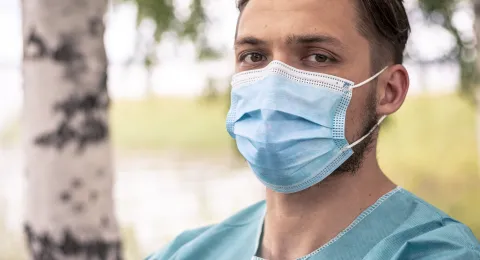What kind of properties should face masks have?
Well, at least it has to protect the wearer from bacteria and viruses, preferably in both ways. It has to be well-fitting for the face and, if possible, also see-through to help observe the wearer's expressions. During the pandemic, it became normal for children and other users to see people wearing masks, which is an arresting thought at least from the perspective of the child's parents. It’s self-evident that people's expressions are important during communication.
The age range of face mask users is from babies to the elderly, including different face shapes and beard styles. Can one model the face mask to fit them all? Most of the single-use face masks are used in healthcare. However, no usual citizen would upset, if in addition to functionality and safety, the face masks would be comfortable to wear and above all, work for its purpose. In the industry, reusable rubber masks have been used, and the material applied is different than for single-use masks. If we want to develop masks, knowledge on materials has clearly a huge role.
Wish list is long
It would be desirable that one would easily breathe through the mask. Many have realized that when running to catch a bus or climbing stairs, one is significantly more out of breath with the mask. The lightness of the mask would not hurt either. The design could also be better, However, the most important part is that face masks would fit tightly to the face. In hospitals, they should also withstand splashes. The list of requirements and expectations is long. At this point, it can be said that the current face masks are highly developed products which interactions aim to get the users to avoid bacteria and viruses that are lurking in the air.
Can the wish list be infinite or is some properties compromise other properties? Or is it even possible to make everything desired possible using today's technologies or do we need to develop new ones?
Materials used
To make the masks materials more environmentally friendly, their properties should be studied and understood. The fact that disposable masks are made of, for example fossil-based polypropylene produced in China is not a coincidence, but rather because the fiber-fabric made from that material has good properties for masks such as, water repellency, porosity and the ability to form fibers of a certain thickness, etc. Since the polymer is thermoplastic, it requires heat and different production techniques to become fiber fabric. Different processes produce fibers of different thicknesses, which can be used to produce different fiber fabrics suitable for different masks. For example a surgical mask can have three layers. The outermost one is made of thicker fiber fabric and the middle part is made from thinner fiber fabric that acts like a filter for bacteria and viruses. Each material has its own properties. Can every existing or even developed polymer be adapted to be suitable for masks? Can a smart feature be added to the material?
Material is one of the most important things BioProt studies. As I already mentioned, most face masks are made in China using fossil-based polymers. Could the material come from, for example, biowaste streams? Could it have the same good properties as the fossil-based material used? Reserving a filter layer has been an important factor in achieving good filtration efficiency. How should new material be modified to make it suitable for masks in the first place? Or could the material be made more environmentally friendly, and after cleaning, it could even decompose when composting? Or could they be cleaned, recycled and reused for some other purpose? If the masks were to be reused, there is no infrastructure and ecosystem suitable for that purpose in Finland.
Smartness to be added
If the mask material was enhanced with antiviral substances that kill viruses and bacteria, there would not be any danger to the user. Could these substances come from our own forests, or can tree cellulose be transformed into thermoplastic polymers? Could an antiviral mask containing such properties already be considered as a smart mask?
Could censors be embedded in the mask to measure various values so they would be safer to use? Somewhere in the world was developed a facemask that would detect coronavirus and show the infection through a color reaction. Could such a mask create more fear among fellow humans than provide safety for the wearer?
Most importantly, what kind of intelligence addition is desirable and useful or economically feasible in terms of cost and data collection?
Lots of questions to be answered
BioProt is trying to answer at least some of those questions. As the reader can see, questions arise around every aspect. That’s good because it at least raises awareness and understanding that developing masks is not a simple matter and requires time and research to develop.
Krista Koljonen, Project manager of BioProt
You can find this text also In Finnish here.
More information

Eveliina Repo


